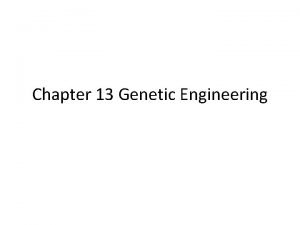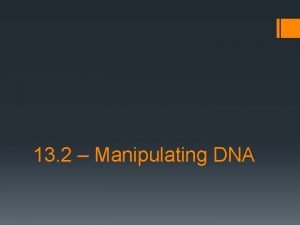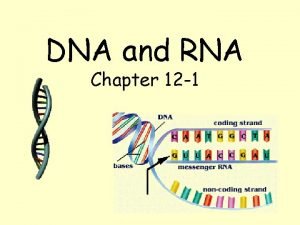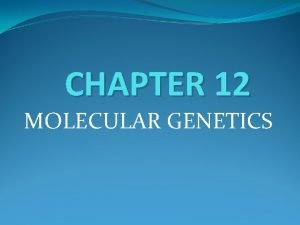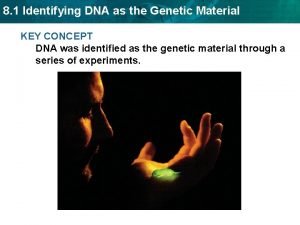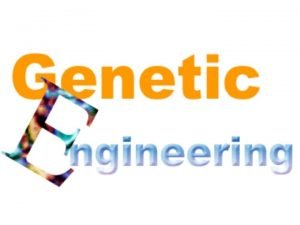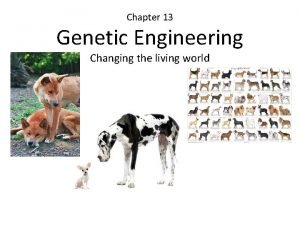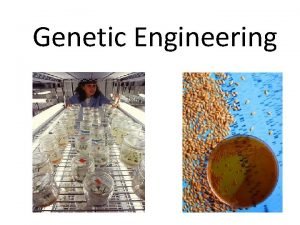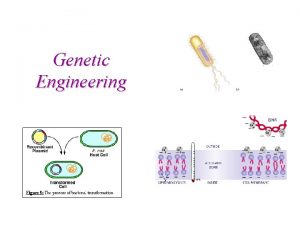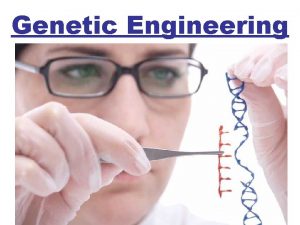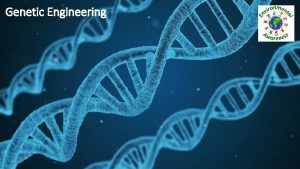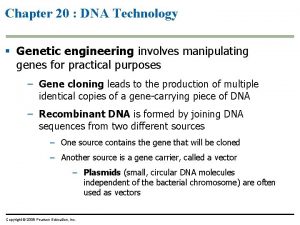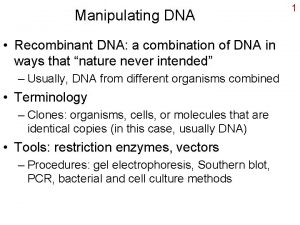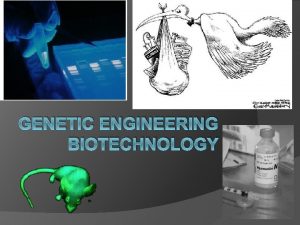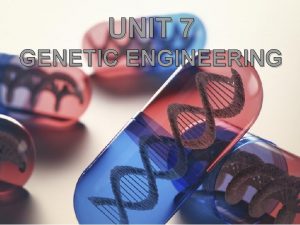Chapter 13 Genetic Engineering 13 2 Manipulating DNA















- Slides: 15

Chapter 13 Genetic Engineering

13– 2 Manipulating DNA – A. The Tools of Molecular Biology • 1. DNA Extraction • 2. Cutting DNA • 3. Separating DNA – B. Using the DNA Sequence • 1. Reading the Sequence • 2. Cutting and Pasting • 3. Making Copies

Extracting DNA • How can we get DNA out of a cell or cells?

• 1. Copy the following series of DNA nucleotides onto a sheet of paper. • GTACTAGGTTAACTGTACTATCGTTAACGTAAGCTACGTT AACCTA • 2. Look carefully at the series, and find this sequence of letters: GTTAAC. It may appear more than once. • 3. When you find it, divide the sequence in half with a mark of your pencil. You will divide it between the T and the A. This produces short segments of DNA. How many occurrences of the sequence GTTAAC can you find?

• DNA can be cut into segments using restriction enzymes. • Bacteria have been battling viral infections for millions of years. There defense is to cut up the DNA of the virus by using enzymes.

Recognition sequences Restriction enzyme Eco. RI cuts the DNA into fragments. Sticky end

Separating DNA Gel electrophoresis DNA plus restriction enzyme Power source Longer fragments Shorter fragments Mixture of DNA fragments

• Longer fragments will move ______ than shorter fragments.

Figure 13 -7 DNA Sequencing Section 13 -2 DNA sequencing

Making recombinant DNA Section 13 -3 Recombinant DNA Gene for human growth hormone Human Cell Bacterial Cell Sticky ends DNA recombination DNA insertion Bacterial chromosome Plasmid Bacterial cell for containing gene for human growth hormone

Interest Grabber The Good With the Bad Section 13 -4 The manipulation of DNA allows scientists to do some interesting things. Scientists have developed many transgenic organisms, which are organisms that contain genes from other organisms. Recently, scientists have removed a gene for green fluorescent protein from a jellyfish and tried to insert it into a monkey.

Flowchart Section 13 -4 Cloning A body cell is taken from a donor animal. An egg cell is taken from a donor animal. The nucleus is removed from the egg. The body cell and egg are fused by electric shock. The fused cell begins dividing, becoming an embryo. The embryo is implanted into the uterus of a foster mother. The embryo develops into a cloned animal.

Figure 13 -13 Cloning of the First Mammal Section 13 -4 A donor cell is taken from a sheep’s udder. Donor Nucleus These two cells are fused using an electric shock. Fused Cell Egg Cell The nucleus of the egg cell is removed. An egg cell is taken from an adult female sheep. The fused cell begins dividing normally. Embryo Cloned Lamb The embryo develops normally into a lamb —Dolly Foster Mother The embryo is placed in the uterus of a foster mother.

Can you imagine penguin clones!

 Section 13-2 manipulating dna
Section 13-2 manipulating dna 13-2 manipulating dna
13-2 manipulating dna 13-2 manipulating dna
13-2 manipulating dna Chapter 12 section 1 dna the genetic material
Chapter 12 section 1 dna the genetic material Chapter 12 section 1: dna: the genetic material
Chapter 12 section 1: dna: the genetic material Chapter 12 molecular genetics
Chapter 12 molecular genetics Chapter 12 dna the genetic material
Chapter 12 dna the genetic material Chapter 12 section 1 dna the genetic material
Chapter 12 section 1 dna the genetic material Founder population
Founder population Genetic programming vs genetic algorithm
Genetic programming vs genetic algorithm Genetic programming vs genetic algorithm
Genetic programming vs genetic algorithm What is the difference between genetic drift and gene flow
What is the difference between genetic drift and gene flow Genetic drift vs genetic flow
Genetic drift vs genetic flow Section 1 identifying dna as the genetic material
Section 1 identifying dna as the genetic material Insulin bacteria genetic engineering
Insulin bacteria genetic engineering Section 13-1 changing the living world
Section 13-1 changing the living world
